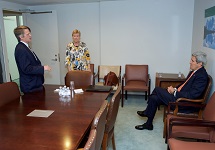Farnaz Alimehri
April 27, 2016
The following is an excerpt from an article published April 18 by the Georgetown Security Studies Review.

Secretary Kerry in briefing before he addresses NPT Conference at U.N. in New York in 2015.
Source: WikiMedia Commons
At the 2015 Review Conference for the Treaty on the Non-Proliferation of Nuclear Weapons (NPT), efforts to establish part of the Middle East Weapons of Mass Destruction Free Zone (MEWMDFZ) were defeated when the participating states failed to agree on the agenda for a regional nuclear weapons conference.
Eliminating weapons of mass destruction in the Middle East is not a new idea—in 1974, Egypt and Iran proposed a joint initiative that led to United Nations General Assembly Resolution 3236, which called for the establishment of a MENWFZ. In 1990, another initiative offered by Egypt led to the zone’s expansion to include all weapons of mass destruction (WMD). Further progress was made at the 1995 Review Conference, where general consensus to move forward was reached through a resolution that would establish a Middle East Nuclear Weapon Free Zone. Under this resolution, Middle Eastern states would have been required to sign on to the NPT if they had not already done so, and full-scope IAEA safeguards would have been applied to all regional nuclear facilities. However, this resolution was never implemented.
Among other factors, ethnic and religious rivalries resurfaced as a number of Middle Eastern countries singled out Israel for its nuclear monopoly, stymieing any possibility of regional consensus. It appears that the most recent efforts have similarly been thwarted; however, such a setback should not dissuade all parties from continuing to advocate for nuclear weapons free Middle East.
